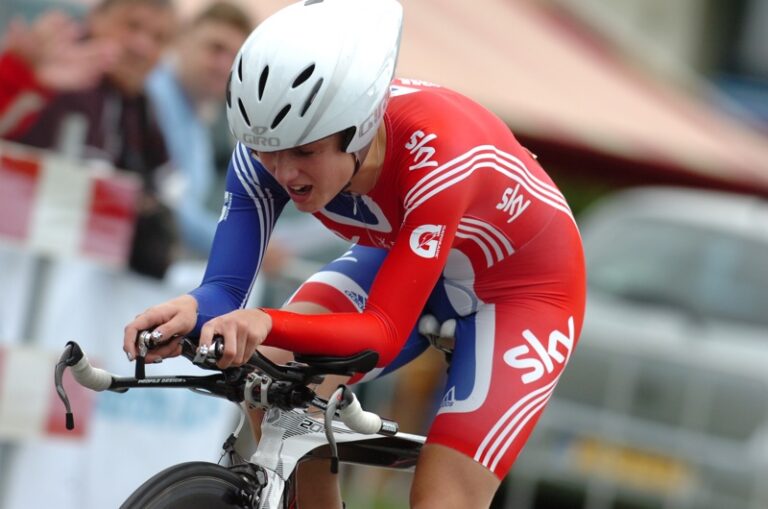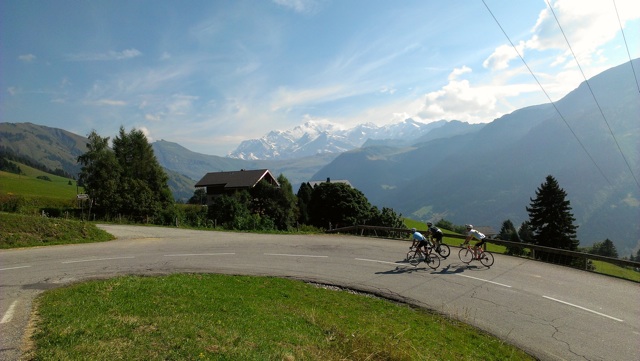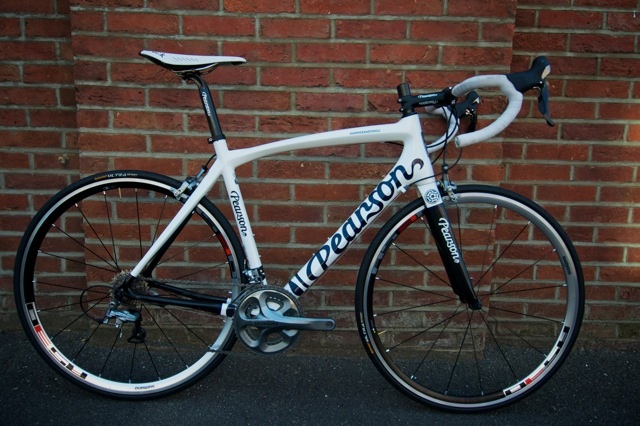When UK distributor i-ride, whose brands include De Rosa and Campagnolo, asked us to ride the world’s first production bike with Campag’s Athena EPS group, we hot-footed it to their East Sussex HQ to take the machine for a spin.

When i-ride called it the world’s first production bike, they weren’t joking. They only have nine Campagnolo Athena EPS groupsets in stock, of which only one has so far been built up with De Rosa’s Merak frameset – and we were the first to take it for a ride. Our 45-mile route criss-crossed the South Downs, up and over Ditchling Beacon, and, while far from a conclusive test, gave us the opportunity to get to grips with both Athena EPS and the Merak.
Campagnolo launched Athena EPS (that’s Electronic Power Shift) in July with the aim of replicating the performance of their existing Record and Super Record EPS groups (themselves only launched eight months ago) but at a significantly reduced cost. By skipping Chorus, which remains mechanical-only, Campagnolo have placed Athena EPS in direct competition with Shimano Ultegra Di2.
How so? Some of the carbon fibre from its older and more illustrious siblings is stripped out, with the Athena EPS front derailleur cage made from steel, while the outer plate and jockey wheel cage on the rear derailleur are aluminium, as are the brake and shift lever blades.
Claimed weight for Athena EPS is 2,352g with a carbon crank, or 2,452g with an aluminum crank, compared to 2,184g for Record EPS and 2,098g for Super Record EPS. Otherwise Athena EPS matches Record and Super Record EPS in shifter function, speed, motor torque and battery life. So how did it perform?

Crisp, clean shifting
By sharing the technology used on Campagnolo’s existing electronic groups, Athena EPS provides, crisp, clean shifting – first time, every time. It just works, and the shifters provide a positive response (more on that later), with little room for error. This is, of course, heavily engineered and expensive technology and you’d expect nothing less.
Athena EPS also works remarkably well under load. Move up a gear when climbing out of the saddle and you can expect a smooth shift, while moving from the small ring to the big while pedalling furiously, again, created few problems.
The front mech has an auto-trim feature which means it will move automatically to avoid chain rub when, for example running the big ring with the big cassette sprocket, like we tried. Shift one gear at a time and the front mech will auto-trim once the chain hits the sprocket, or, if multi-shifting, it’ll wait until you release the button before correcting itself, although its reaction time, while still quick, is not as sharp as Di2.
The front derailleur works with standard or compact chainrings (paired on our machine with an 11-25t cassette), while the rear mech can handle a cassette with with up to 29 teeth.
Otherwise, the Athena EPS battery can run for up to 2,000km, depending on how many shifts you execute, or 6 months on standby. A stem-mounted LED indicator tells you how much charge you have left using a traffic light system. Should you run out of battery while riding (although there is little excuse), the EPS Ride Back Home function allows you to manually uncouple the rear derailleur to position it on the best sprocket to get you home.

MultiDome and MultiShifting Technology
Campagnolo’s mechanical groupsets have long been about feel – that ‘Campagnolo click feeling’ – and the Italian firm’s looked to emulate that in their electronic groups, with MultiDome shifting technology carried down to Athena EPS.
In contrast to the rear paddle and dimpled button of Di2 groupsets, which differ considerably from Shimano’s moving STI lever, Campagnolo have used layers of domed spring steel beneath what look like their traditional shifting buttons to push a sensor which triggers the front or rear mech, thereby recreating the Campagnolo shifting sensation – feel and touch – we’ve come to expect. We tested Ultegra Di2 in summer, but we’d speculate that the close proximity of the shifting buttons could be fiddly when wearing thick winter gloves, but there’s little cause for concern here.
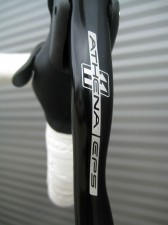
Where Athena EPS does differ to its mechanical equivalent is the evolution of MultiShifting. Not a new concept to Campagnolo fans, MultiShifting has previously allowed riders using the brand’s mechanical groups to shift down five sprockets or up three in a single action – on Athena EPS you can move across the whole cassette, from the smallest sprocket to the biggest if you want, by holding the relevant shifter for one-and-a-half seconds. Or, of course, you can sweep across the cassette as much or little as you want by varying the length of time you hold the shifter.
That takes practice – but it’s not a fine art; the rear mech is still required to move up the cassette sprocket-by-sprocket and you can, if you’re quick that is, count your way along. By the end of my test ride I was getting to grips with the shifting variations and was confident that, with a few more miles in the bank, the wider MultiShifting range would become second nature.
Rarely will you find the need to shift all the way across the whole cassette but MultiShifting is infinitely useful on the UK’s rolling roads, when often you’ll come off a fast descent on to a steep ramp of, say, ten per cent, at the bottom of which you can almost instantly select the desired gear and pedal away, rather than lose momentum manually shifting from gear to gear.
So that’s Campagnolo Athena EPS. Our initial test ride revealed a superbly executed piece of engineering which opens up Electronic Power Shifting to a far wider market, which is exactly what Campagnolo set out to do when Athena EPS was first put on the drawing boards. At the moment it’s only offered with the De Rosa Merak but it should be available as an aftermarket product later this year for approximately £1,800.

De Rosa Merak
But what about the machine with which it was paired? This was, after all, our first opportunity to swing a leg over the De Rosa Merak. The Merak is fourth in line to the De Rosa throne, beneath the Protos, Super King and King, but this remains a performance machine with a price tag to match – £1,999.99 for the frame and fork or £4,299.99 for the Athena EPS build.
The frame was overhauled for 2012 and has a BB30 bottom bracket paired with a box-section downtube, a toptube which curves and flows into the seatstays, with nods to aerodynamics thanks to the cut-away seattube and aero-profile seatpost (De Rosa switched from an integrated to regular seatpost on the Merak for 2012). It’s a hybrid frame, which means it can run either a mechanical or electronic groupset.
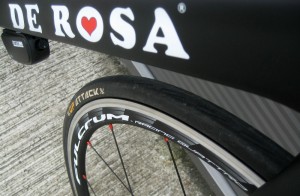
Initial ride impressions? The marriage of a BB30 bottom bracket with the Merak’s huge downtube make for a frame which is very stiff and engaging, responding efficiently to both seated and out of the saddle accelerations, ideal for the rolling roads which made up most of my route.
They weren’t all rolling, however, and the climb of Ditchling Beacon (a one-mile climb, averaging ten per cent and made famous as the last hurdle for amateur cyclists on the famous London to Brighton ride) provided a good test of the Merak’s ability going uphill and it responded well to the Beacon’s inconsistent gradient.
De Rosa are an Italian firm with a racing heritage and that DNA is fed into the Merak which, with a headtube length of just 155mm on our 55cm test model. It’s behaviour betrays its heritage, always asking for more from the rider – more than this test pilot was able to produce. Speaking of the headtube, it’s a tapered affair which makes for a rigid front end with pin-point handling, but the fork transmitted a fair amount of vibration from East Sussex’s poor road surfaces.
Of course, our two-and-a-half hour ride isn’t a thorough examination of the Merak’s capabilities but first impressions count for much. The spec is made up of Fulcrum’s new-for-2013 Racing Quattro wheels (which we will be testing in their own right in September), with Continental Ultra Sport 23c tyres, 3T Ergosum Pro ‘bars and Arx Pro stem, Prologo Zero Ti 1.4 saddle and De Rosa handlebar tape. Our scales recorded a weight of 7.45kg.

